WASHINGTON, June 19, 2012 /PRNewswire/ -- Top-performing companies in the food, beverage and household products sectors that leverage the demand chain will be in the best position to continue to grow, according to the 2012 Financial Performance Report by the Grocery Manufacturers Association (GMA) and PwC US, titled Profitable Growth: Driving the Demand Chain.
(Logo: http://photos.prnewswire.com/prnh/20100917/NY66894LOGO )
In 2011, both top and bottom performing companies* saw their sales growth continue to revive. The food, beverage and household products sectors each showed continued strong net sales growth of 9.5 percent, 10.5 percent, and 7.5 percent respectively.
According to the report, consumer packaged goods (CPG) companies and retailers should invest in brands by leveraging the demand chain to better identify and meet consumer needs. The links in a typical CPG demand chain can include front-end sales, marketing, customer service, trade promotions, brick-and-mortar retail partners, online retailers, social media sites and reverse logistics or end-of-product-life recycling. The report includes a breakdown of the CPG sector's top-performing companies, explores direct-to-consumer touch points, consumer demand for sustainable product, and overseas expansion as a way to fuel future growth.
"Perhaps more so than in any other sector, CPG companies constantly monitor the temperature of the consumer," said GMA President and CEO Pamela G. Bailey. "Consumer demand moves so fast, only those with fast, nimble and cost-effective supply and demand chains will be able to keep pace."
"CPG companies that shift new strategic investments to their demand chain will stand the best chance of creating new growth," said Susan McPartlin, PwC's US leader, retail and consumer industry. "The series of activities that sparks and maintains a brand – the demand chain – should be just as integral a part of strategic decisions as are operations and the supply chain."
Now in its 16th year, the GMA-PwC Financial Performance Report includes analyses based on public information from 142 companies in the food, beverage and consumer products sectors as well as 67 retailers.
Among the key findings:
- Investment in brands and in long-term positioning remains a significant predictor of performance and is critical to effective demand chain management.
- For the first time since 2008, the bottom performing group enjoyed higher net sales growth.
- Some top performers expanded sustainability initiatives with an eye towards cutting costs while driving growth by building consumer interest in socially and environmentally responsible product.
- Retailers have a slightly better performance than manufacturers with regard to shareholder returns: 10.3 percent vs. 8.7 percent.
- Over the past five years, top performing companies have spent more on defending their market share than bottom performing companies, as measured by strategic median selling, general, and administrative (SG&A) spending relative to sales.
- Strong liquidity continues to give top performing companies more options to invest in R&D, innovation and acquisitions.
- Many top performers have continued to invest heavily in emerging markets, with the goal of building trust among consumers.
According to the report, exports from CPG companies continue to rise as international markets present greater growth opportunities. Emerging markets remain the most promising source of economic growth as the expanding middle class consumes more, with U.S. exports of CPG products to the largest emerging nation purchasers (China/Hong Kong, Taiwan, South Korea, and the Philippines) almost tripling between 2005 and 2011, from $5 billion to $13 billion. Between 2005 and 2011, total exports of CPG products essentially doubled, from $40.3 billion to $80.3 billion. The $40 billion increase was split evenly between traditional export markets (the European Union, Canada, Japan, and Mexico increased from $26 billion to $46 billion) and emerging economies (which increased from $14 billion to $34 billion).
"There have been positive economic developments over the past year that paint a more promising picture. But while market risks persist, CPG companies need to stay nimble, informed, and be adaptive in a higher-risk environment that brings unanticipated events," added Lisa Feigen Dugal, PwC's North American advisory leader, retail and consumer industry. "Three factors that CPG executives need to consider include: continued commodity price volatility, how emerging markets – despite the growth opportunities – bring the uncertainties of developing economies, and new government policies could represent fundamental changes to the tax, regulatory and operating environments."
Profitable Growth: Driving the Demand Chain will be presented via webcast by PwC and GMA on Monday, June 25 at 1:30 p.m. EDT (click here for registration information: http://www.meetpwc.com/2012financialperformancereport). For an electronic copy of the complete report, visit: www.pwc.com/us/retailandconsumer or www.gmaonline.org.
*A quartile analysis based on three fundamental metrics: economic profit spread (based on return on invested capital and the weighted average cost of capital); return on assets; free cash flow relative to sales.
About the Grocery Manufacturers Association
Based in Washington, D.C., the Grocery Manufacturers Association is the voice of more than 300 leading food, beverage and consumer product companies that sustain and enhance the quality of life for hundreds of millions of people in the United States and around the globe.
Founded in 1908, GMA is an active, vocal advocate for its member companies and a trusted source of information about the industry and the products consumers rely on and enjoy every day. The association and its member companies are committed to meeting the needs of consumers through product innovation, responsible business practices and effective public policy solutions developed through a genuine partnership with policymakers and other stakeholders.
In keeping with its founding principles, GMA helps its members produce safe products through a strong and ongoing commitment to scientific research, testing and evaluation and to providing consumers with the products, tools and information they need to achieve a healthy diet and an active lifestyle.
The food, beverage and consumer packaged goods industry in the United States generates sales of $2.1 trillion annually, employs 14 million workers and contributes $1 trillion in added value to the economy every year. For more information, visit the GMA Web site at www.gmaonline.org.
About the PwC Network
PwC firms help organizations and individuals create the value they're looking for. We're a network of firms in 158 countries with close to 169,000 people who are committed to delivering quality in assurance, tax and advisory services. Tell us what matters to you and find out more by visiting us at www.pwc.com.
© 2012 PricewaterhouseCoopers LLP, a Delaware limited liability partnership. All rights reserved. PwC refers to the US member firm, and may sometimes refer to the PwC network. Each member firm is a separate legal entity. Please see www.pwc.com/structure for further details.
This content is for general information purposes only, and should not be used as a substitute for consultation with professional advisors.
SOURCE PwC
WANT YOUR COMPANY'S NEWS FEATURED ON PRNEWSWIRE.COM?
Newsrooms &
Influencers
Digital Media
Outlets
Journalists
Opted In





Share this article